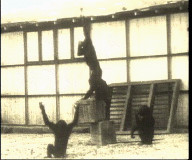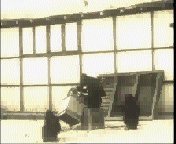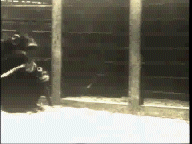German Gestalt Psychologists: Lewin and Köhler
Kurt Lewin's videos on psychological fields: Toddlers trying to sit on an
attractive stone
Vygotsky wrote, "Lewin's demonstration of the great difficulty a small
child has in realizing that he must first turn his back to a stone in order to
sit on it illustrates the extent to which a very young child is bound in every
action by situational constrains. It is hard to imagine a greater contrast to
Lewin's experiment showing the situational constraints on activity than what
we observe in play. It is here that the child learns to act in a cognitive,
rather than an externally visual, realm by relying on internal tendencies and
motives and not on incentives supplied by external things. A study by Lewin on
the motivating nature of things for a very young child concludes that 'things'
dictate to the child what he must do: a door demands to be opened and closed,
a staircase to be climbed, a bell to be rung. In short, things have such an
inherent motivating force with respect to a very young child's actions and so
extensively to determine the child's behavior that Lewin arrived at the notion
of creating a psychological topology: he expressed mathematically the
trajectory of the child's movements in a field according to the distribution
of things with varying attracting or repelling forces." (Vygotsky, 1978,
Mind in Society, p. 96)

Video: Click on picture
|
Hannahs Versuch (Hannah's Trial)
Hannah is one year and seven months old. The stone has a positive valence in
the momentary living space of the child. The child is attracted by the
stone. In order to sit down, the child has to turn around, that is away from
the goal. This detour to reach the goal is extremely difficult for children.
|

Video: Click on picture |
Han's Erfolg (Han's success)
Hans solves the problem in a smart fashion. He does not lose sight of his
goal. |
https://psychologie.fernuni-hagen.de/lernportal/Verzeichnisse/Video.html#Hanna
Wolfgang Köhler's experiments on ape's
intelligence
Köhler, W. (1973). The mentality of apes. London: Routledge and Kegan
Paul.

Video: Click on picture
|
Kisten-Einzelversuch (boxes individual trials)
Today's exercise does not show any direct signs of of insightful behavior.
Koehler's exact observations during the first few trials of the animals,
however, showed this very clearly. |

Video: Click on picture
|
Kisten-Gruppenversuch (boxes group trial)
If you look closely, you can see first signs of cooperative behavior in
using tools. |

Video: Click on picture
|
Doppelstockversuch (not sure, I think it is supposed to mean "two stick
trial")
This film was taken one months after the first successful two stick trial by
Sultan. We can see several discrete trials separated by pauses. |
https://psychologie.fernuni-hagen.de/lernportal/Verzeichnisse/Video.html#Affen
 hits since March 10, 2007
hits since March 10, 2007




